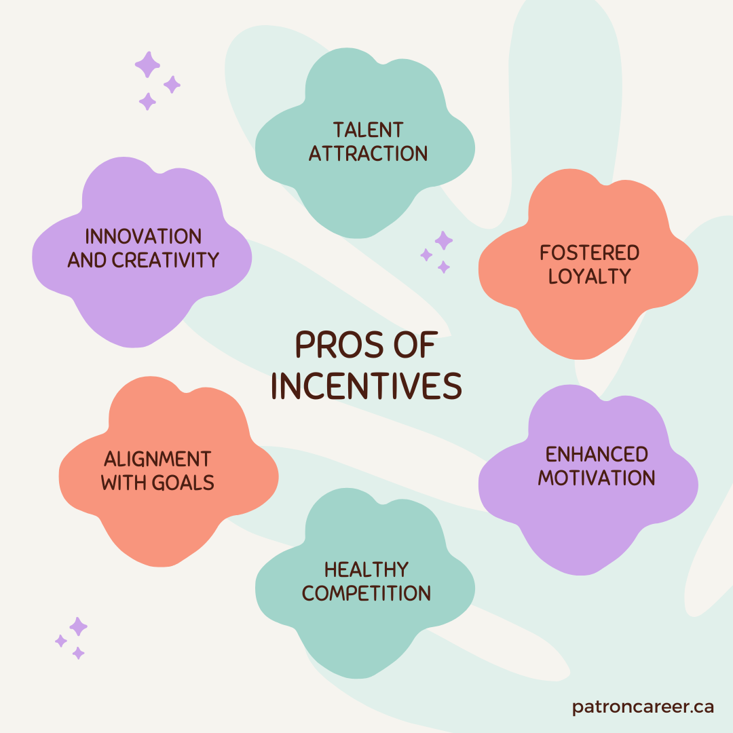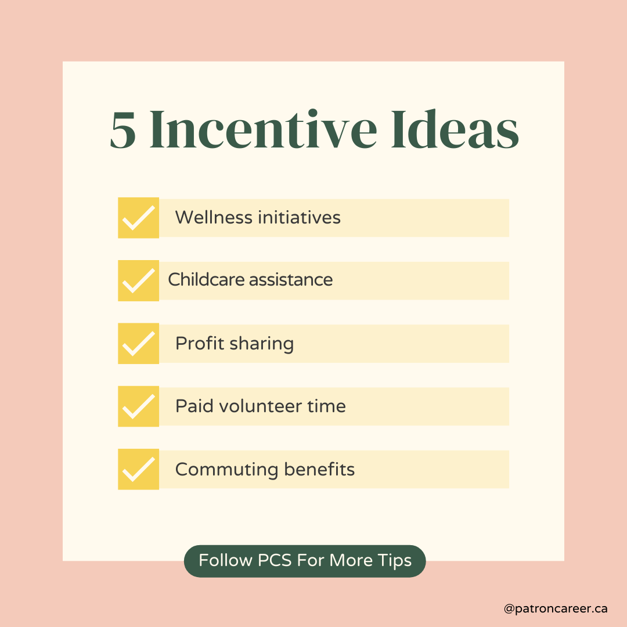
Trend of Job Hopping
28 July, 2023
Patron Career Staffing firmly believes in adopting a tailored approach to meet temporary and permanent recruitment needs. We safeguard the interest of our clients by finding such workers who are knowledgeable and reliable.
About UsNeed help? Make a Call
32 Dundas Street East Unit A, L5A1W2

In the dynamic world of business, organizations are continuously exploring innovative strategies to enhance their competitiveness and achieve competitive advantage. One crucial aspect of this endeavour is nurturing a motivated and engaged workforce that is ready to toil to achieve organizational success. Employee incentives, a strategic approach to recognizing and rewarding exceptional performance, have emerged as a potent tool in achieving this objective. In this comprehensive article, we delve deep into the realm of employee incentives, unveiling their diverse types, benefits, implementation methods, and providing inspiring ideas to empower organizations to elevate their employee morale and engagement to new heights.
Understanding Incentives?
Employee incentives encompass a wide array of rewards, recognition, and perks that organizations offer to employees beyond their regular compensation and benefits. These incentives are designed to celebrate employees' outstanding achievements, commitment, and contributions, thereby fostering a culture of appreciation, motivation, and dedication within the workplace.
Benefits of Giving Employee Incentives

1. Enhanced Morale: Incentives are a tangible demonstration of an employee's value to the organization, significantly boosting their morale and job satisfaction. Employees who feel appreciated are more likely to be engaged and proactive in their roles.
2. Increased Engagement: Recognition and rewards create a sense of personal investment and belonging among employees. This heightened engagement leads to improved collaboration, innovation, and overall productivity.
3. Improved Performance: Employee incentives provide an added layer of motivation for employees to consistently deliver their best performance. The prospect of receiving rewards or recognition can inspire them to exceed expectations and achieve excellence.
4. Talent Retention: Organizations that invest in employee incentives often experience reduced turnover rates. Employees are more likely to stay in an environment where their efforts are acknowledged and rewarded.
5. Team Cohesion: Incentive programs can promote a healthy sense of competition and camaraderie among team members. This fosters a positive work atmosphere and enhances team cohesion.
Also Read: Quiet Quitting: Understanding, Preventing, and Combating Employee Disengagement.
Implementing Employee Incentives
To ensure the effectiveness of incentive programs, organizations should consider the following steps:
1. Clear Goals: Establish specific and measurable performance metrics or achievements that warrant recognition and rewards. Clarity in criteria ensures that employees understand the expectations.
2. Tailored Approach: Recognize that different employees are motivated by various incentives. Understand their preferences, whether they are motivated by financial rewards, professional development, or non-monetary perks.
3. Timely Recognition: Incentives should be timely to maintain relevance. Recognize achievements promptly, as this maximizes the impact and reinforces desired behavior.
4. Consistency: Ensure fairness and consistency in distributing incentives. Unequal treatment can lead to demotivation and discord among employees.
5. Communication: Clearly communicate the criteria for receiving incentives and the significance of each reward. Transparency eliminates confusion and ensures that employees strive for the right objectives.
Also Read: How to Encourage Internal Whistleblowing amongst Your Workforce
Types of Employee Incentives
The range of employee incentives is diverse and can be tailored to suit the unique needs and preferences of the workforce. Here are some prevalent types:
1. Monetary Incentives: These include performance-based bonuses, profit-sharing schemes, commission structures, and stock options. These rewards directly impact an employee's financial well-being, making them highly motivating.
2. Non-Monetary Incentives: Often, employees value work-life balance and flexibility more than monetary rewards. Offering benefits such as flexible work hours, telecommuting options, and additional paid time off can contribute significantly to job satisfaction.
3. Recognition Awards: Public acknowledgment is a powerful motivator. Recognize outstanding employees through certificates, plaques, "Employee of the Month" titles, or even company-wide announcements.
4. Professional Development: Invest in employees' growth by offering opportunities for skill enhancement, workshops, certifications, and career advancement programs. This not only benefits the employee but also enhances the organization's talent pool.
5. Gifts and Vouchers: Tangible gifts like gift cards, merchandise, or vouchers for experiences like dining, shopping, or entertainment provide a personalized touch to recognition.
6. Team Celebrations: Organize team outings, parties, or lunches to celebrate collective achievements. These events foster a sense of unity and shared success among team members.
Employee Incentive Ideas- Tips to Follow

1. Performance Bonuses: Reward exceptional achievements, surpassing targets, or going the extra mile with substantial monetary bonuses.
2. Wellness Packages: Prioritize employee well-being by offering gym memberships, wellness retreats, meditation classes, or access to online wellness platforms.
3. Remote Work Options: Acknowledge top performers by providing the flexibility to work remotely, balancing work and personal life.
4. Skill-Building Workshops: Invest in employees' professional development by sending them to industry conferences, workshops, and online courses that align with their interests and career goals.
5. Extra Vacation Days: Recognize sustained effort by granting additional paid time off, allowing employees to recharge and return to work with renewed vigor.
6. Peer Recognition Programs: Implement a system where employees can nominate their peers for exceptional efforts, fostering a culture of recognition and teamwork.
Lastly…
Employee incentives are a dynamic and essential tool for cultivating a motivated, engaged, and high- performing workforce. By offering diverse rewards, recognition, and perks, organizations can create an environment where employees feel valued, appreciated, and eager to contribute their best efforts. Whether it's through monetary rewards, non-monetary benefits, or opportunities for growth and development, the art of giving incentives can uplift both individual employees and the entire organization. In this journey, organizations embark on a transformation where employee morale and engagement flourish, driving the path to sustained success.
Follow us to learn more about the ways of the business world!
